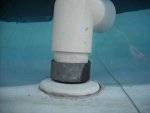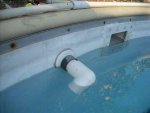We bought a house with an inground pool with vinyl liner this year. It's been a learning process to understand the chemical balance and care, but I finally got it right. However, the pool is losing water ~1"- 1 1/2" per day. I found leaking (by dye test) around the inlet/return pipe and I want to repair this. What would be the proper sealant to use (caulking or glue?), and any special precautions to take? I noticed the previous sealant is drying and obviously losing the seal, so I think I should remove this as much as possible first before applying new sealant. I asked at the pool store and they didn't have a clue what to use. Just a patch kit, but this won't work because there is no hole! I haven't checked yet, but I also think the sealant between the liner and the steps may be leaking because it is drying and small pieces end up in the pool as we swim. Would there be anything different using sealant there because that will be completely submerged underwater? Thank you in advance.
Pool Repair Around Inlet And Skimmer Faceplate
- Thread starter nruslen
- Start date
You are using an out of date browser. It may not display this or other websites correctly.
You should upgrade or use an alternative browser.
You should upgrade or use an alternative browser.
Welcome to TFP!!
Are the faceplates cracked? If so, just replace them, it's easy and can be done with the pool full. Short of being cracked, they don't usually fail. The gaskets are submerged so dry rot isn't very likely and that's about the only thing that will ruin them.
I'd try a vessel test wherein you plug off all the suction and return ports, mark the water level in the pool ans fill and mark a bucket set on the steps. Leave overnight and compare loss of water in the pool v.s. that in the bucket. This will help identify whether or not the leak is in the plumbing.
Are the faceplates cracked? If so, just replace them, it's easy and can be done with the pool full. Short of being cracked, they don't usually fail. The gaskets are submerged so dry rot isn't very likely and that's about the only thing that will ruin them.
I'd try a vessel test wherein you plug off all the suction and return ports, mark the water level in the pool ans fill and mark a bucket set on the steps. Leave overnight and compare loss of water in the pool v.s. that in the bucket. This will help identify whether or not the leak is in the plumbing.
The faceplates have no obvious signs of cracking. Unfortunately, the pool was emptied for ~2 years by the previous owner, which is from what I understand a big No No. So I guess that means it is a strong possibility it is the gaskets? I see the skimmer faceplate has screws, so I would unscrew and replace plate & gasket? No caulking, glue, etc? It appears like they did this around the edges previously, so maybe this was a hack job to make it temporarily last? Around the return pipe I don't understand as much, the faceplate has no screws and definitely has some type of sealant around it. What would that be? I will try the other leak testing too, to see if any leaks are in the plumbing. How do you plug the return and skimmer? Thank you again, really appreciating this site!
The skimmer's gaskets are made of ~compressed fiber and are unlikely to fail even if left dry for a while - I'm not saying they can't fail, but I've seen some ancient ones that would still be serviceable (but we replace them anyway, as long as we're in there  )
)
Try removing the directional eyeballs on the returns, some of them have a cover plate that hides both the screws and the real sealing plate - which still may be cracked. The eyeballs are a 3 piece deal, a retaining ring, which holds the eyeball, the eyeball and the 'seat'.
Sorry to ask you to do more homework, but we might just be on to something here
Try removing the directional eyeballs on the returns, some of them have a cover plate that hides both the screws and the real sealing plate - which still may be cracked. The eyeballs are a 3 piece deal, a retaining ring, which holds the eyeball, the eyeball and the 'seat'.
Sorry to ask you to do more homework, but we might just be on to something here
I will do as much homework as it takes!
I took pictures because my return does not match the description you gave. I see no cover plate to remove. I think it may be attached by screwing into a piece on the outside of the pool, with the plumbing, but I am not going to touch that unless I have to. Do you see what I mean about sealant/glue around these faceplates? I plan to do the leak test this weekend. Any other things I should check for the water loss?
Thank you again for hanging in there with me!
I took pictures because my return does not match the description you gave. I see no cover plate to remove. I think it may be attached by screwing into a piece on the outside of the pool, with the plumbing, but I am not going to touch that unless I have to. Do you see what I mean about sealant/glue around these faceplates? I plan to do the leak test this weekend. Any other things I should check for the water loss?
Thank you again for hanging in there with me!
Attachments
Looks like an ag return with a compression nut to tighten things up. This is an in-ground?
**********************************************************************nruslen said:I will do as much homework as it takes!
I took pictures because my return does not match the description you gave. I see no cover plate to remove. I think it may be attached by screwing into a piece on the outside of the pool, with the plumbing, but I am not going to touch that unless I have to. Do you see what I mean about sealant/glue around these faceplates? I plan to do the leak test this weekend. Any other things I should check for the water loss?
Thank you again for hanging in there with me!
My suggestion on how to find out if the return line or the skimmer is the point of the leak is this:
Let it set and see at which level the pool stops leaking. Looks like the skimmer and the return outlet re at different levels. If it stops at the return line then it is the return line but if it continues past it and stops at the skimmer at some point then that is where your leak it.
Thread Status
Hello , This thread has been inactive for over 60 days. New postings here are unlikely to be seen or responded to by other members. For better visibility, consider Starting A New Thread.



